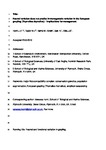Neutral variation does not predict immunogenetic variation in the European grayling (Thymallus thymallus) - implications for management
| dc.contributor.author | Huml, JV | |
| dc.contributor.author | Taylor, MI | |
| dc.contributor.author | Harris, WE | |
| dc.contributor.author | Sen, R | |
| dc.contributor.author | Ellis, Jonathan | |
| dc.date.accessioned | 2018-09-07T16:02:20Z | |
| dc.date.issued | 2018-11 | |
| dc.identifier.issn | 0962-1083 | |
| dc.identifier.issn | 1365-294X | |
| dc.identifier.uri | http://hdl.handle.net/10026.1/12250 | |
| dc.description.abstract |
<jats:title>Abstract</jats:title><jats:p>Preservation of genetic diversity is critical to successful conservation, and there is increasing demand for the inclusion of ecologically meaningful genetic information in management decisions. Supportive breeding programmes are increasingly implemented to combat declines in many species, yet their effect on adaptive genetic variation is understudied. This is despite the fact that supportive breeding may interfere with natural evolutionary processes. Here, we assessed the performance of neutral and adaptive markers (major histocompatibility complex; <jats:styled-content style="fixed-case">MHC</jats:styled-content>) to inform management of European grayling (<jats:italic>Thymallus thymallus</jats:italic>), which routinely involves supplementation of natural populations with hatchery‐reared fish (stocking). This study is the first to characterize <jats:styled-content style="fixed-case">MH II DAA</jats:styled-content> and <jats:styled-content style="fixed-case">DAB</jats:styled-content> loci in grayling and to investigate immune genetic variation in relation to management practice in this species. High‐throughput Illumina sequencing of “introduced,” “stocked native” and “non‐stocked native” populations revealed significantly higher levels of allelic richness and heterozygosity for <jats:styled-content style="fixed-case">MH</jats:styled-content> markers than microsatellites exclusively in non‐stocked native populations. Likewise, significantly lower differentiation at the <jats:styled-content style="fixed-case">MH II</jats:styled-content> than for microsatellites was apparent when considering non‐stocked native populations, but not stocked populations. We developed a simulation model to test the effects of relaxation of selection during the early life stage within captivity. Dependent on the census population size and stocking intensity, there may be long‐term effects of stocking on <jats:styled-content style="fixed-case">MH II</jats:styled-content>, but not neutral genetic diversity. This is consistent with our empirical results. This study highlights the necessity for considering adaptive genetic variation in conservation decisions and raises concerns about the efficiency of stocking as a management practice.</jats:p> | |
| dc.format.extent | 4157-4173 | |
| dc.format.medium | Print-Electronic | |
| dc.language | en | |
| dc.language.iso | en | |
| dc.publisher | Wiley | |
| dc.rights | Attribution-NonCommercial-NoDerivatives 4.0 International | |
| dc.rights | Attribution-NonCommercial-NoDerivatives 4.0 International | |
| dc.rights | Attribution-NonCommercial-NoDerivatives 4.0 International | |
| dc.rights.uri | http://creativecommons.org/licenses/by-nc-nd/4.0/ | |
| dc.rights.uri | http://creativecommons.org/licenses/by-nc-nd/4.0/ | |
| dc.rights.uri | http://creativecommons.org/licenses/by-nc-nd/4.0/ | |
| dc.subject | amplicon sequencing | |
| dc.subject | conservation genetics | |
| dc.subject | European grayling (Thymallus thymallus) | |
| dc.subject | major histocompatibility complex | |
| dc.subject | population augmentation | |
| dc.title | Neutral variation does not predict immunogenetic variation in the European grayling (Thymallus thymallus) - implications for management | |
| dc.type | journal-article | |
| dc.type | Journal Article | |
| dc.type | Research Support, Non-U.S. Gov't | |
| plymouth.author-url | https://www.webofscience.com/api/gateway?GWVersion=2&SrcApp=PARTNER_APP&SrcAuth=LinksAMR&KeyUT=WOS:000449800900002&DestLinkType=FullRecord&DestApp=ALL_WOS&UsrCustomerID=11bb513d99f797142bcfeffcc58ea008 | |
| plymouth.issue | 21 | |
| plymouth.volume | 27 | |
| plymouth.publication-status | Published | |
| plymouth.journal | Molecular Ecology | |
| dc.identifier.doi | 10.1111/mec.14864 | |
| plymouth.organisational-group | /Plymouth | |
| plymouth.organisational-group | /Plymouth/Faculty of Science and Engineering | |
| plymouth.organisational-group | /Plymouth/Faculty of Science and Engineering/School of Biological and Marine Sciences | |
| plymouth.organisational-group | /Plymouth/REF 2021 Researchers by UoA | |
| plymouth.organisational-group | /Plymouth/REF 2021 Researchers by UoA/UoA06 Agriculture, Veterinary and Food Science | |
| plymouth.organisational-group | /Plymouth/REF 2021 Researchers by UoA/UoA07 Earth Systems and Environmental Sciences | |
| plymouth.organisational-group | /Plymouth/Users by role | |
| plymouth.organisational-group | /Plymouth/Users by role/Academics | |
| dc.publisher.place | England | |
| dcterms.dateAccepted | 2018-08-29 | |
| dc.rights.embargodate | 2019-9-8 | |
| dc.identifier.eissn | 1365-294X | |
| dc.rights.embargoperiod | Not known | |
| rioxxterms.versionofrecord | 10.1111/mec.14864 | |
| rioxxterms.licenseref.uri | http://creativecommons.org/licenses/by-nc-nd/4.0/ | |
| rioxxterms.licenseref.startdate | 2018-11 | |
| rioxxterms.type | Journal Article/Review |



